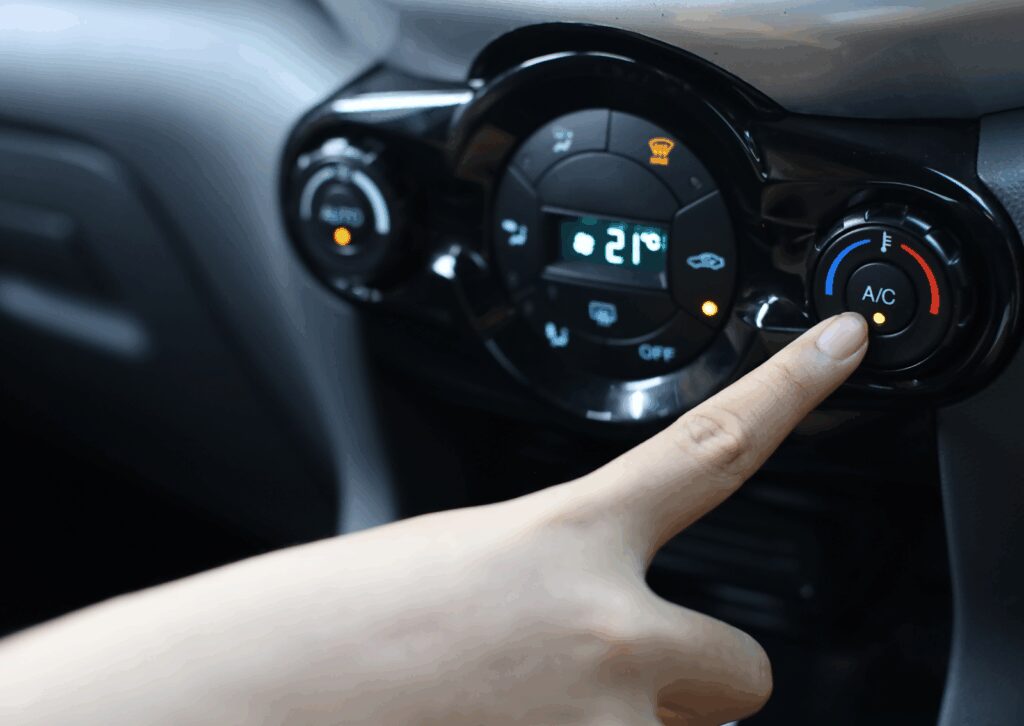When we get into our vehicles on a hot summer day or a freezing winter morning, we expect the climate control system to work instantly. What many drivers don’t realize is that this comfort depends heavily on the vehicle’s electrical system. From powering the air conditioning and heating systems to ensuring each sensor and switch communicates properly, your electrical system does much more than just start the engine.
At Metric Motors, we’ve seen firsthand how a faulty car battery, worn-out alternator, or damaged wiring can affect everything from cabin temperature to airflow strength. In this article, we’re breaking down how your car’s electrical system impacts the performance of your climate control and why staying on top of these electrical components is essential for comfort, safety, and long-term reliable operation.
How Does the Vehicle’s Electrical System Influence Air Conditioning Performance?

When we think about staying comfortable in our vehicle, we usually focus on the air conditioning system, but what powers it? Behind the dash, it’s the vehicle’s electrical system doing the heavy lifting. Whether you’re trying to cool down in the summer or warm up in the winter, the electrical system supplies the necessary electrical power to run fans, blowers, compressors, and sensors.
Without a stable battery voltage and consistent current from your alternator, your air conditioning won’t function the way it should. Many electrical components work together, drawing from the car battery and distributing electrical energy through dedicated electrical circuits. This complex network of wiring, sensors, and modules ensures your climate system responds accurately to your settings.
What Are the Key Components in Car Electrical Systems That Affect Climate Control?

Your car electrical systems are made up of multiple essential components that support the climate system’s performance. These key components include the ignition switch, starter motor, battery, alternator, and more.
-
The ignition switch powers on the system
-
The starter motor cranks the engine
-
The alternator recharges the battery while the vehicle runs
-
The car battery stores electrical energy and powers accessories like air conditioning, power windows, and lights when the engine is off
In modern vehicles, these systems are tightly integrated. The climate system relies on sensors and electronic systems to monitor voltage levels, cabin temperature, and outside conditions. If the battery’s charge drops too low, the AC may underperform or shut off altogether.
How Do Electrical Circuits and Ancillary Circuits Support Climate Control Features?

In most cars, electrical circuits are like the highways that move electrical energy to the correct destinations. The climate control system is part of a network of ancillary circuits that handle comfort-related functions, such as power windows, interior lights, and infotainment systems.
If these circuits become damaged or overloaded, the air conditioning may suffer. Improper current flows or aging wiring can lead to short circuits, preventing components from operating efficiently. That’s why it’s crucial to ensure these various components have a clean and secure path for electrical power.
Why Is the Car Battery Crucial for Your Vehicle’s Climate System?

The car battery is more than a one-start wonder. It plays a critical role in powering your vehicle’s climate control features, especially when the engine is off. When fully charged, it provides the power source for fans, thermostats, and air conditioning sensors.
If you have a dead battery, your AC won’t even turn on. Even a slightly drained battery pack can cause the system to behave erratically. Add in a faulty alternator, and you’ll see everything from weak fan output to inaccurate temperature readings. Routine maintenance and checking battery voltage are key to a reliable operation.
Can Short Circuits Disrupt Your Car’s Climate Control System?

Yes, they can. Short circuits occur when unintended connections create low-resistance paths in the electrical system, leading to sudden voltage drops or component failures. This often affects climate control because of how integrated these systems are in modern vehicles.
Over time, frayed wiring, corroded battery terminals, or even damage to the negative terminal and positive terminal can result in a short circuit. These issues can trigger HVAC error codes or disable blower motors and fans. Referring to service manuals and performing regular diagnostics can help isolate the issue before it causes bigger problems.
How Does the Ignition System Interact with Air Conditioning in Most Cars?

The ignition system doesn’t just start the engine. It also activates a range of electrical components, including those responsible for air conditioning. When the ignition switch is turned, current flows through the ignition coil and spark plugs, converting electrical energy into mechanical energy needed to start the engine.
Once the vehicle is running, the ignition system continues to support accessory systems, including climate controls. Any failure in the ignition coil or air-fuel mixture management can reduce the efficiency of the HVAC system. Faulty ignition timing can even cause surges or drops in available electrical power, affecting how well your climate control responds.
What Role Do Electrical and Electronic Systems Play in Energy Efficiency?

Today’s vehicles are smarter and more connected than ever. Electronic systems use sensors and processors to maximize energy efficiency, including when it comes to running your AC system. These components work in real-time, adjusting fan speeds, thermostat levels, and vent direction based on cabin feedback.
In electric vehicles, where power conservation is key, the electrical system must balance energy between propulsion and comfort systems like AC. Here, every amp counts. In both gas and electric vehicles, failing electrical components can lead to inefficiencies that make your HVAC system work harder and drain more energy.
Is a Jump Start Safe for Climate Control Systems and Other Electrical Features?

A jump start can be a quick fix for a dead battery, but it’s not always safe for sensitive electrical components. If done incorrectly, it may overload ancillary circuits or damage the HVAC control unit. Always follow safe jumper cable practices:
-
Connect to the positive terminal first
-
Then attach to a clean, secure connection on the negative earth system
-
Never connect the final clamp to the battery terminal itself
Using a working vehicle to restore a charged battery should only be a temporary measure. If your AC doesn’t function properly after a jump, get the system inspected.
What Are the Warning Signs of an Electrical System Problem Affecting Climate Control?

There are clear warning signs that your electrical system might be affecting your air conditioning performance:
-
Inconsistent fan speeds or airflow
-
AC cutting out while driving
-
Flickering cabin lights
-
Unusual noises when the AC kicks in
-
Fuel gauge not responding
-
Weak or unresponsive ignition
These symptoms often point to deeper issues with the battery, alternator, or internal wiring loom. Left unchecked, even minor faults can turn into serious HVAC system problems.
Need Help Diagnosing Electrical Issues in Your Vehicle’s Climate Control System?

If you’re dealing with erratic climate control, weak airflow, or AC that just won’t stay on, it’s time to get your electrical system checked out. At Metric Motors, we specialize in pinpointing the root cause of electrical issues before they become major problems. Whether it’s a faulty alternator, a deteriorating battery pack, or a failing sensor in the HVAC system, we’ll find it and fix it.
We offer advanced diagnostics, factory-grade tools, and certified technicians trained to work with modern vehicles. Our team will ensure every component is working as it should, from the car battery and starter motor to the air conditioning system and beyond.
Don’t risk a complete AC breakdown this summer. Call Metric Motors today to schedule your electrical diagnostic and get back to a comfortable ride. Our team is ready to help you with everything from jump starts to full electrical system repairs.
Final Thoughts
We understand how frustrating it can be when your vehicle’s air conditioning system starts acting up. What many drivers don’t realize is just how much the vehicle’s electrical system controls those comfort features. From your car battery and alternator to the intricate circuits and wiring loom, every piece has to function smoothly to keep your ride cool and comfortable.
The electrical system not only supplies power to your climate system, but it also plays a crucial role in coordinating airflow, temperature, and cabin pressure. Managing this intricate process is essential, especially when factors like a full fuel tank or high-pressure coolant cycles come into play. Each component depends on another to ensure your system stays efficient and dependable.
At Metric Motors, we take pride in offering honest, high-quality electrical repair services for Loveland drivers. Our team is here to make sure your climate control system works efficiently and reliably, no matter the weather. Let us keep you powered, cooled, and ready for the road.
Frequently Asked Questions:
1. How does my vehicle’s electrical system affect the air conditioning?
The vehicle’s electrical system powers all components of your air conditioning, including fans, sensors, and compressors. Without proper electrical power, your climate control won’t function effectively.
2. What are the key electrical components that control climate performance?
Essential electrical components include the car battery, alternator, ignition switch, starter motor, and the electrical circuits that connect everything. Each part is vital for smooth HVAC performance.
3. Can a weak car battery affect the climate control system?
Yes. A dead battery or low battery voltage can prevent your AC from turning on or functioning properly. It’s crucial to maintain a charged battery for consistent comfort.
4. What role does the alternator play in air conditioning performance?
The alternator recharges the car battery while the engine is running. If it fails, it can’t supply power to the AC system, leading to reduced airflow or total failure.
5. What are short circuits and how do they affect climate control?
Short circuits are unintended paths in the electrical system that cause voltage drops or equipment failure. They can shut down fans or cause the HVAC system to malfunction.
6. Can ignition system problems impact my vehicle’s AC?
Yes. The ignition system controls how electrical energy flows once the engine is on. Faulty spark plugs, an ignition coil, or ignition switch can disrupt AC functions.
7. Are jump starts safe for the electrical system and air conditioning?
Jump starting is safe if done correctly. However, improper use of jumper cables can overload ancillary circuits, potentially damaging your air conditioning and other sensitive electronics.
8. What warning signs suggest an electrical issue is affecting my AC?
Watch for weak airflow, flickering lights, unresponsive fuel gauge, and inconsistent cooling. These are signs of possible issues in your wiring loom, battery terminals, or alternator.
9. How do electronic systems improve energy efficiency in climate control?
Electronic systems monitor cabin conditions in real time to manage AC output, helping to optimize energy efficiency—especially important in electric vehicles.
10. When should I bring my vehicle in for an electrical inspection?
If you notice any performance issues with your climate control, engine starting, or interior electronics, it’s time for an inspection. A quick check can prevent more expensive repairs later on.





